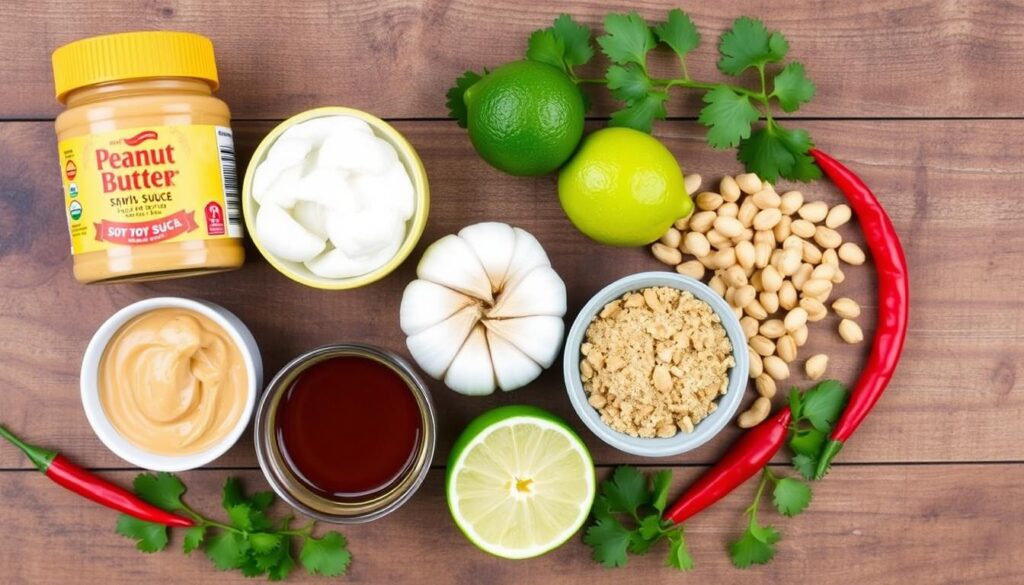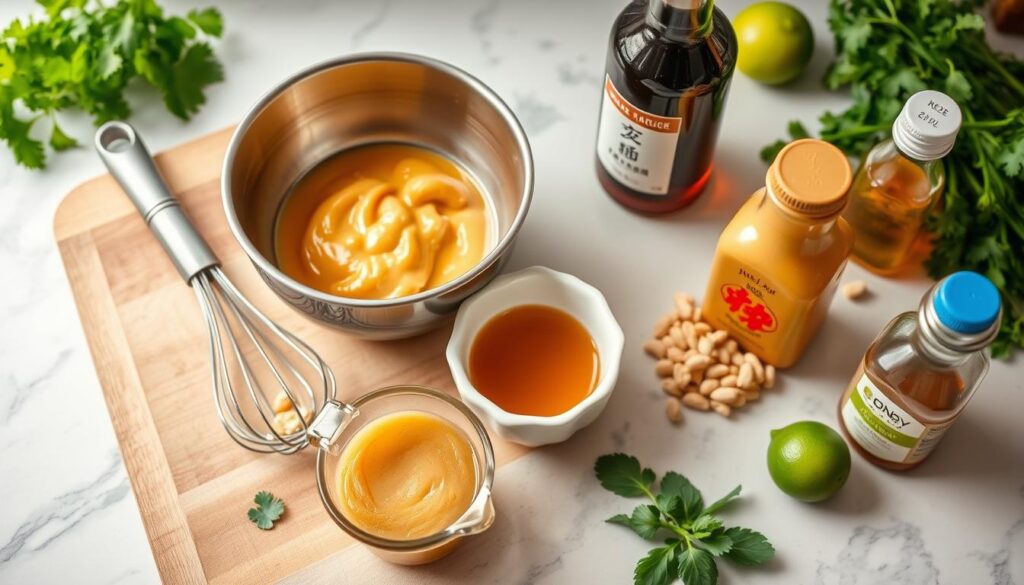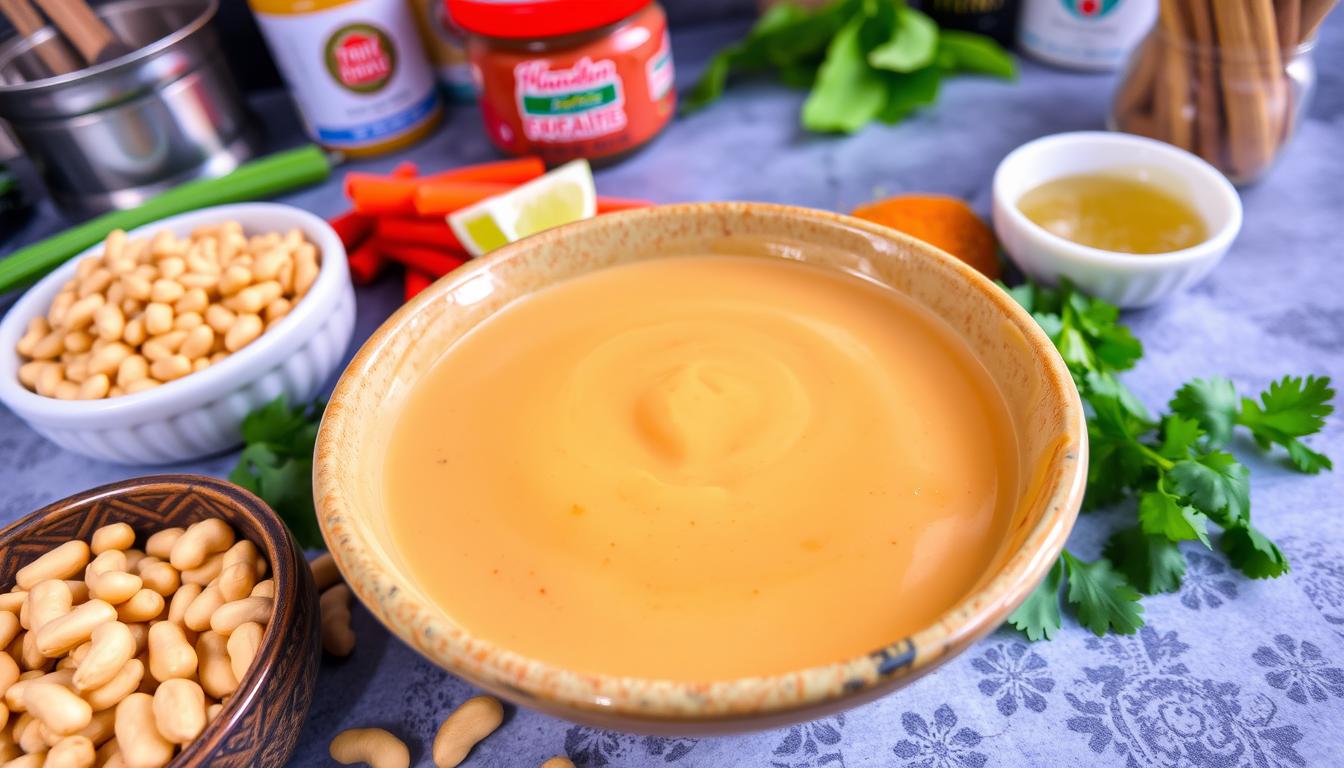The smell of peanuts and spices fills your kitchen, taking you to Bangkok’s busy streets. As you taste the creamy, golden sauce, memories of your first time trying authentic Thai peanut sauce come back. Now, you can make that magic in your own kitchen with this quick and easy recipe.
In just 10 minutes, you’ll learn to make a versatile Thai peanut sauce that makes any dish better. This recipe brings together sweet, salty, and tangy flavors, just like authentic Thai dishes. Whether you’re a pro in the kitchen or just starting out, this sauce will be your go-to.
Get ready to wow your family and friends with a sauce that’s easy to make but full of complex flavors. This peanut sauce recipe is more than a condiment. It’s a way to dive into the rich world of Thai cuisine from your own kitchen.
What Makes Thai Peanut Sauce Special
Thai peanut sauce is a key part of Thai cuisine, loved for its rich taste and smooth texture. It’s become a hit in kitchens all over the world. It’s moved far beyond its roots in Southeast Asia.
Origins in Southeast Asian Cuisine
The history of Thai peanut sauce starts in Indonesia, where it’s called satay sauce. It spread across Southeast Asia, changing into different versions. In Thailand, it became a key part of authentic Thai dishes, known for its sweet and spicy taste.

Cultural Significance in Thai Cooking
In Thai culture, peanut sauce is more than a sauce. It’s a sign of culinary skill, mixing sweet, salty, and spicy flavors. It’s used in dishes like satay and spring rolls, showing the mix of tastes that make Thai food special.
Versatility in Modern Kitchen
Now, Thai peanut sauce is used in kitchens everywhere. It’s loved for its ability to fit into many dishes. It can serve as a dip, marinade, or dressing. It adds flavor to many meals, making it a favorite for food lovers.
“Thai peanut sauce is like a flavor explosion in your mouth. It’s the perfect blend of sweet, savory, and spicy that keeps you coming back for more.”
Essential Ingredients for Authentic Peanut Sauce Recipe
Starting a delicious thai peanut sauce means getting the right ingredients. These key components will bring your sauce to life:

Smooth peanut butter is the base. Pick a natural, unsweetened one for the best taste. Coconut milk adds richness and a hint of tropical flavor. Soy sauce brings saltiness and umami, while lime juice adds a zesty kick.
Spices are crucial in your peanut butter sauce. Garlic and ginger add aromatic depth. Red pepper flakes or sriracha sauce add heat. A hint of sweetness from brown sugar perfectly balances the flavors.
| Ingredient | Quantity | Role in Sauce |
|---|---|---|
| Peanut Butter | 1/2 cup | Base and main flavor |
| Coconut Milk | 1/4 cup | Creaminess and texture |
| Soy Sauce | 2 tablespoons | Saltiness and depth |
| Lime Juice | 1 tablespoon | Acidity and brightness |
| Brown Sugar | 1 tablespoon | Sweetness and balance |
For more flavor, try adding fish sauce or rice vinegar. These add to the sauce’s authenticity. They create a perfect mix of sweet, salty, and tangy.
Kitchen Tools You’ll Need
Making the perfect peanut sauce for your Thai dishes is easy. You don’t need fancy tools. Just a few basic items and some optional gadgets will help you make tasty sauces fast.
Basic Equipment Requirements
To begin your peanut sauce journey, you’ll need these basic items:
- Mixing bowl
- Whisk or fork
- Measuring cups and spoons
- Sharp knife
- Cutting board
Optional Time-Saving Tools
For a smoother sauce and quicker prep, consider these tools:
- Blender or food processor
- Microplane grater for garlic and ginger
- Electric mixer for large batches

Storage Container Recommendations
Storing your Thai peanut sauce right is important. Choose from these options:
| Container Type | Benefits | Best For |
|---|---|---|
| Glass jars | Airtight, reusable, microwave-safe | Long-term storage |
| Plastic containers | Lightweight, stackable | Short-term use |
| Squeeze bottles | Easy dispensing, portion control | Frequent use |
With these tools, you’re set to start your peanut sauce recipe adventure. You’ll be able to make your Thai dishes even better.
Step-by-Step Preparation Method
Making the perfect thai peanut sauce is an art. Follow these steps to make an authentic thai sauce that will make your dishes stand out.
Ingredient Preparation Tips
Begin by gathering fresh ingredients for your peanut sauce. Use unsalted peanut butter for better flavor. Chop garlic and ginger finely so they blend smoothly. Measure soy sauce, lime juice, and brown sugar carefully.
Mixing Technique
Start by mixing peanut butter and coconut milk in a bowl. Whisk until it’s smooth. Then, add soy sauce, lime juice, brown sugar, garlic, and ginger. Mix well.
For a spicier sauce, add red pepper flakes or sriracha. Blend all ingredients until they’re well combined.
Consistency Adjustments
To get the perfect texture, adjust the sauce’s consistency. If it’s too thick, add warm water or coconut milk slowly. For a thicker sauce, add more peanut butter.
Taste and adjust the seasoning as needed.
| Consistency | Adjustment | Amount |
|---|---|---|
| Too Thick | Warm Water | 1 tbsp at a time |
| Too Thin | Peanut Butter | 1 tsp at a time |
| More Flavor | Soy Sauce | 1/2 tsp at a time |
By following these steps, you’ll make a delicious thai peanut sauce. Experiment with flavors to find your perfect balance.
Customizing Your Sauce’s Heat and Flavor
Your thai peanut sauce is a blank canvas for creativity. Start with a basic recipe and then adjust it to your liking. For a spicy sauce, add red pepper flakes or sriracha. If you want it milder, cut down the chili or use sweet chili sauce.
Adjusting the sweetness is easy too. Use honey for a natural sweetness or brown sugar for a deeper flavor. For a tangy twist, add more lime juice or a bit of rice vinegar. Try different peanut butters – smooth for creaminess or crunchy for texture.
Garlic fans can increase the garlic for more flavor. Roasting the garlic before adding it can add a special touch. Ginger adds a zesty flavor – use fresh grated ginger for the best taste.
- Spicy: Add chili flakes or hot sauce
- Sweet: Incorporate honey or brown sugar
- Tangy: Increase lime juice or add rice vinegar
- Aromatic: Double garlic or add fresh ginger
Creating the perfect peanut sauce is all about balance. Taste and adjust as you go. Your sauce will make any dish, from noodles to spring rolls, uniquely yours.
Serving Suggestions and Pairings
Your homemade peanut dipping sauce is ready! Now, let’s explore exciting ways to serve it. From traditional Thai dishes to modern fusion creations, there’s no shortage of delicious pairings.
Traditional Thai Accompaniments
In Thai cuisine, peanut sauce is a staple. Serve it as a dip for grilled chicken satay skewers or fresh spring rolls. It’s also perfect for drizzling over a crispy Thai salad or as a sauce for pad thai noodles.
Modern Fusion Applications
Get creative with your satay sauce! Try it as a pizza sauce for a Thai-inspired pie. You can even mix it into your favorite stir-fry for an extra punch of flavor.
Vegetarian and Vegan Options
Vegan peanut sauce is incredibly versatile for plant-based dishes. Toss it with roasted vegetables or use it as a dip for raw veggie sticks. It’s great for jazzing up tofu dishes or as a dressing for Buddha bowls.
| Dish Type | Peanut Sauce Pairing |
|---|---|
| Appetizer | Vegetable spring rolls with peanut dipping sauce |
| Main Course | Grilled tofu satay with peanut sauce |
| Salad | Thai-inspired slaw with peanut dressing |
| Snack | Fresh cut veggies with vegan peanut sauce |
Remember, the key to enjoying your peanut sauce is experimentation. Don’t be afraid to try new combinations and discover your favorite pairings!
Storage Tips and Shelf Life
Your homemade thai peanut sauce recipe needs the right storage to keep its taste. Refrigeration is crucial for keeping your sauce fresh and safe. Pour the cooled sauce into an airtight container and then into the fridge. This way, your sauce will stay fresh for up to a week.
Freezing is a good option for longer storage. Use freezer-safe containers or ice cube trays to divide your sauce. Frozen peanut sauce can last up to three months without losing its flavor. When you’re ready, thaw it in the fridge overnight.
Watch your sauce for signs of spoilage. If you see odd smells, mold, or texture changes, throw it away. Always use clean utensils to scoop out portions to avoid contamination.
- Store in an airtight container in the refrigerator for up to one week
- Freeze in portions for up to 3 months
- Thaw frozen sauce overnight in the fridge
- Check for signs of spoilage before use
By following these storage tips, your peanut sauce will stay fresh for your next Thai meal. Proper storage keeps your sauce fresh and preserves its rich flavors and creamy texture.
Common Mistakes to Avoid
Making the perfect peanut sauce for Thai dishes can be tricky. Here’s a look at some common mistakes and tips to avoid them.
Texture Troubles
One big issue is getting the sauce’s consistency right. If it’s too thick, it’s hard to mix. If it’s too thin, it won’t stick to your food. Start with less liquid and add more until it’s just right.
If it’s too runny, simmer it to make it thicker. Or add more peanut butter.
Flavor Imbalance
Getting the flavors right is crucial in Thai peanut sauce. If one flavor is too strong, it messes up the whole sauce. Taste it as you go and adjust the sweetness, saltiness, and spiciness.
Storage Slip-ups
Storing your peanut sauce properly is important. Keep it in an airtight container in the fridge and use it within a week. For longer storage, freeze it in small portions.
Never leave the sauce at room temperature for too long. This can cause it to spoil.
- Use fresh ingredients for the best flavor
- Avoid overheating, which can separate the sauce
- Label and date your stored sauce
By avoiding these common mistakes, you’ll get better at making Thai peanut sauce. Try different ratios and ingredients to find your favorite mix!
Conclusion
Making your own Thai peanut sauce at home is easier than you think. This authentic Thai recipe brings Southeast Asia’s flavors to your kitchen in just 10 minutes. With a few key ingredients and basic tools, you can make a delicious sauce that rivals any restaurant version.
This peanut sauce recipe is versatile, letting you customize it to your liking. Whether you like it spicy or mild, chunky or smooth, you can adjust the ingredients to make it just right. Use it as a dip, a salad dressing, or a marinade for grilled meats and vegetables.
Don’t be afraid to try new things with this Thai peanut sauce. Experiment with different add-ins or pair it with new dishes to find exciting flavor combinations. With proper storage, you can enjoy your homemade sauce for days. So grab your blender and give this easy recipe a try. You’ll be amazed at how quickly you can create an authentic Thai taste at home.

